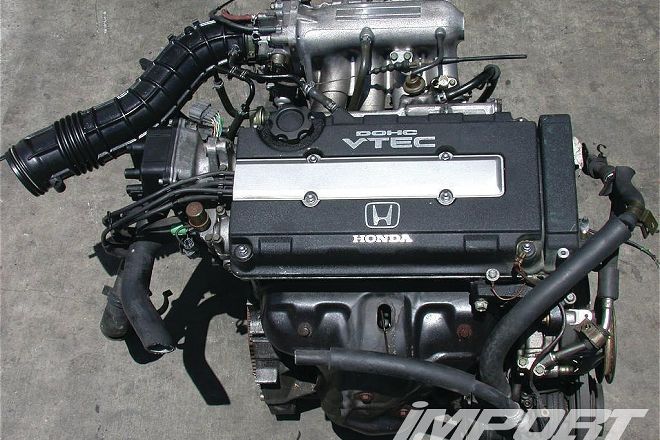Fact: Eric Hsu will be picking his favorite tech question for each installment of Question IT over the next few months, and we’ll be hooking up whoever submitted it with some new threads from our go-fast homies at Eat Sleep Race. Charles comes up this month, for asking Eric WTF the B16A-swapped Civic he just built can’t take out the single-cammer Civic he’s been putting around in for years, prompting the big guy to reply with the ABCs of engine diagnostics—something we’d all be wise to read.
Got a good one? Get some gear:
Crying Game
Well, I guess you can call this a question and a sob story. I recently picked up a ’93 Civic EX coupe with a B16A1 swap for $600—yes six hundred. The chassis has high mileage but even living here in PA, the rust is extremely minimal to my surprise, as this is the third Civic I’ve owned in two years. The sob part of this story is that my previous ’94 Civic DX coupe with a Y7/Z6 mini-me engine conversion with a DC Sport header, test pipe, cat-back exhaust, short-ram intake, high-compression head gasket, adjustable fuel pressure regulator, ’95 Si transmission, and stock P28 ECU is definitely faster/quicker than my “new” Civic. I don’t understand why this is possible if the B16A1 is rated at 170 hp stock. What can I do to change the fact that my old single slammer would have eaten this thing alive? I recently bought a B18A1 with a spun rod bearing for $80 and am considering an LS/VTEC conversion with a Brian Crower 2.2L stroker setup. I would also like to install a Full-Race turbo kit after I break the motor in, but I’m curious as to how much abuse the stroker kit can handle? Obviously, I will need to purchase some ARP head studs, a block girdle, aggressive lift/duration camshafts and supporting valvetrain. Any help/info for this 19-year old is appreciated.
-Charles Shirey
Slippery Rock, PA
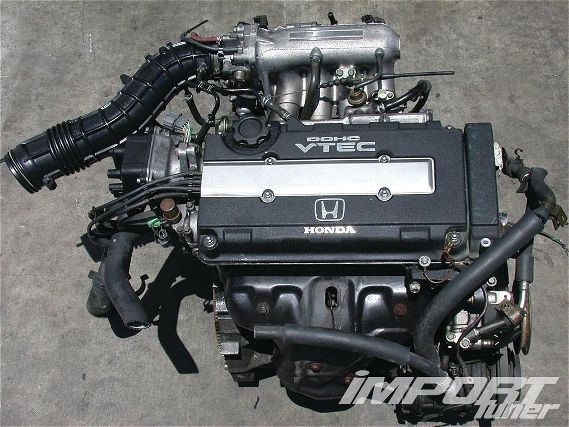 |
B16A1 Honda Engine Swap - Question It
|
B16A1 Honda Engine Swap - Question It
Considering that the B16A1 first appeared in 1990, you could very well have a 20-year-old engine. Naturally aspirated engines will eventually become tired and make a lot less power over time due to abuse and high mileage. Aside from the usual diagnosing, which should entail checking the ignition timing, fuel filter, fuel pressure, etc., you should also check the engine’s compression and then do a leakdown test before deciding to throw parts at it. The compression test will give you an overall view of the engine’s health by giving you an idea of the engine’s ability to compress the air/fuel mixture. If an engine has worn rings or a leaking head gasket, it will affect the engine’s ability to compress the air/fuel mixture. You can buy a compression tester at the local auto parts store. Begin by testing the engine by pulling the ECU fuse and cranking it over with the throttle wide open. A healthy engine should be getting somewhere in the low 200s with a stock B16. The actual value will depend on the year of your engine so you’ll need to reference a factory service manual for the year of your engine to monitor its condition.
The leakdown test can help you diagnose where a problem resides, but not only will you need a leakdown tester, you’ll also need access to compressed air for this test. A leakdown test can help you diagnose where an engine is hurt. As the test name indicates, the test can show you how much and where the leaks are. With 100 psi of compressed air in your cylinder with its piston at TDC, the leakdown tester will show you what percent leakage there is past the piston rings, intake valves, or exhaust valves. Modern, healthy, stock engines will leak anywhere from 1 to 6 percent, but typically up to 15 percent is acceptable for an engine that is used in anger. Anything over 15 percent means something is probably hurt or worn inside the engine. After you figure out WTF is wrong with the engine, then write back with your budget for your proposed mods.
Tranny Dilemmas
I own an ’85 Supra that I am currently working on and was wondering what engine and transmission I should go with. My initial plans were to go with a 7M-GTE and W58 transmission setup, but after talking with some of my friends, they suggested going with the 2JZ-GTE with an R154 transmission instead. Can you tell me what the pros and cons of going with the 2JZ over the 7M are, and if the W58 transmission will hold up to being mated to a 2JZ? I have a W58 transmission in possession right now and just need to know if I should dump it and get an R154 transmission instead. Thanks!
-Afamefuna U. Nwagbo,
Via importtuner.com
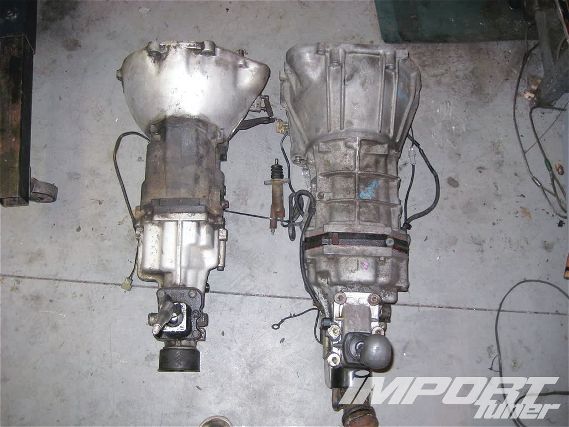 |
B16A1 Honda Engine Swap - Question It
|
B16A1 Honda Engine Swap - Question It
The 7M-GTE is based on the very old architecture of the 1M engine that first appeared in 1965. The 2JZ-GTE is based on the 1JZ that first appeared in the ’90s, making the JZ family of engines a nearly 25-year-old design. Which one would you rather have? As the owner of an MA70 Supra with a 550hp 7M-GTE, I do like 7M engines, but the reality is that the 2JZ-GTE is a far better engine that benefits from Toyota’s many mistakes it made with the “M” engines. While the 7M-GTE’s bottom end is pretty strong, the 2JZ-GTE’s is even stronger as evidenced by the lame-ass, quad-digit-horsepower dyno queen 2JZs found all over the world. The 2JZ’s cylinder head and head gasket design are vastly improved over the 7M, not to mention it flows much better. The quality of crank/cam triggering, sensors, and just about everything else is superior on the 2JZ. It all comes down to your budget since the 2JZ is a lot more expensive than a 7M.
To summarize, if you’re planning on reliable modifications, a 7M with a metal head gasket and ARP head studs will deliver 450 whp all day long and surely get your MA60 hauling way more ass than it does now. If you’ve got the extra money, then a 2JZ will do 500 whp all day long, but will offer an even wider powerband and flatter torque curve than the 7M at 450 whp. As for transmissions, the W58 would easily handle the power of a stock 7M-GTE or even a 2JZ-GTE, but it would depend on the torque output after modifications. The R154 is substantially stronger, since Toyota designed it for turbo duty. If you plan on any kind of serious power with either engine, you’ll want the R154, hands down.
Emissions Legal
Due to emissions regulations and how strict they are becoming, I was wondering if a Nissan RB26DETT or Toyota 4AGE 20v swapped into a registered U.S. car would pass emissions. I know these engines were never originally imported, so how do people get JDM SR20DETs or SR20VEs to pass, legally, and become their daily drivers?
-Juan Salazar
Tucson, AZ.
You cannot get JDM engines to pass emissions tests legally in the U.S. because the factories (Nissan, Toyota, etc.) never spent the money to have them approved by the EPA. Certain engines can slide by if the owner pretends they are the U.S. versions (e.g., Pulsar GTI-R SR20DET swapped in a Sentra SER). A handful of RB26DETTs have been legalized for use on public highways when Motorex legalized BNR32 and BCNR33 Skyline GT-Rs, but there are less than 80 cars that fall into this category. Otherwise, every state has different laws regarding smog tests and engine modifications. Many states do not require smog testing, so people can always get away with using JDM engines since the cars will never be inspected. The more densely populated areas, such as Arizona, have a more lax approach on laws when it comes to the visual aspect of smog tests. The testers will often sign off on the visual inspection as long as the engine burns clean and passes the tailpipe portion of the test. It’s actually pretty easy to get a near-stock engine to pass a tailpipe smog test. A healthy engine, good catalytic converter, and optimized ECU programming can pass most smog tests. In stricter states where smog tests are a sizeable part of the state’s economy, such as California, smog test stations are trained and encouraged to scrutinize engines to ensure they are unmodified and are in perfect working order. JDM engines will never pass in these states because they’ll never get past the visual portion of the test, unless the smog tester misses it. If you’re planning on a JDM engine swap, you might consider re-registering your car with a Yuma address . . . but you didn’t hear that from me.
Freeway Dancing
I own a FWD ’96 Eagle Talon TSI with a stock 4G63 motor and a 3-inch turbo back exhaust. The car recently experienced a problem when stepping on the accelerator to get on the freeway or attempting to pass slow traffic. The Talon builds 7 psi of boost pressure before it begins to sputter and hesitate. It can go over 100 mph but you just can’t floor it. I have changed my fuel filter and replaced my spark plugs with a new set of NGK BRP6SE and also checked for vacuum leaks but came up with no solution and the problem still exists.
-Joseph Willard,
Via importtuner.com
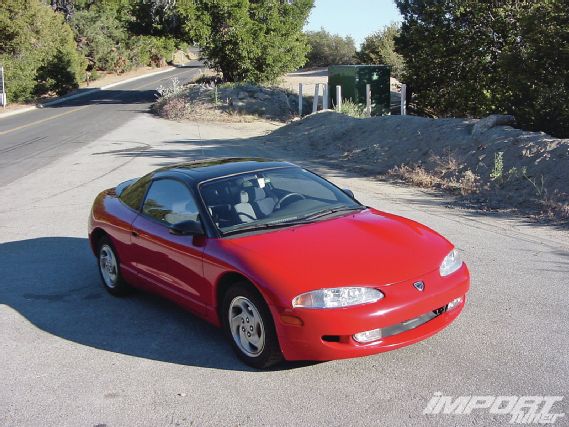 |
B16A1 Honda Engine Swap - Question It
|
B16A1 Honda Engine Swap - Question It
There are a number of possibilities, which include a burnt ignition coil or igniter. Your fuel pump or fuel pressure regulator may also have failed. There could be bad airflow sensor. Since your car is a ’96 model, it has OBD-II. I’m sure your car has a check engine light. Borrow an OBD-II scanner and it will probably tell you what’s wrong. If you’re lucky there might even be freeze frame data on the scanner, making the problem easier to find.
Drift Worthy
I recently purchased an ’89 240SX and am contemplating either swapping out the motor in favor of an SR20DET, RB26DETT, 1JZ-GTE, or rebuilding the stock KA24DE dual-cam engine. I’m building the engine/car for drifting and I’m not sure which motor would suit my aspirations the best.
-Alex Soeffker,
Via importtuner.com
I’ve never been a fan of straight-six engines in an S-chassis car. It’s just plain stupid knowing half of the engine is hanging over the front axle, which ruins the car’s weight distribution. Personally, I prefer a turbocharged KA24DE over any of your other choices. The SR20DET is good and cheap if you can find a good, healthy engine, but considering that red-top SR20s can be 20 years old now, I’d say it’s a crap shoot. My advice would be to rebuild the KA with some forged pistons, rods, head studs, and a Cosworth head gasket (coming soon) for the best results. There’s a multitude of exhaust manifolds and intercooler kits available and plenty of aftermarket ECU support. Also keep in mind that a KA24DE is already a 2.4L engine, which gives it a huge edge in torque over the SR20DET. With a good pair of cams, the KA24DE can make power up to 7,000 rpm also. The RB is 2.6L and the 1J is 2.5L, but both of these engines are probably 100 to 125 pounds heavier than the KA24DE due to the engine size, additional turbo hardware, and the fact that they use two additional cylinders. I suggest you keep it simple and use that extra money you’ll save on suspension, brakes, wheels, etc. You’ll be smoking straight-six S13/14/15s in no time. But if you have the budget, you might also consider a VQ35DE. It’s shorter than the KA24DE’s overall length, which improves weight distribution and the car’s handling. VQ swaps are bit more expensive with the six-speed transmissions, and require a stand-alone ECU, etc., but that’s a whole different story.
Horsepower Disappointment
I own a ’90 JDM twin-turbo Fairlady Z32, which was built by a local performance shop with forged pistons and rods, upgraded Jim Wolf Technology (JWT) Sport 500 turbos and Nismo 555cc/min injectors along with a Nistune ECU. I also had the automatic transmission swapped out for a five-speed. The car was dyno tuned but only made 320 rwhp at 14psi of boost. Could this be right? The engine builder/tuner told me I was losing a lot of horsepower because of the catalytic converters. I was aiming for 500 rwhp. What hp numbers can a fully built VG30DETT deliver? Can you let me know what setup I would need to make 500 rwhp?
-Mark Standen
Abbotsford, BC
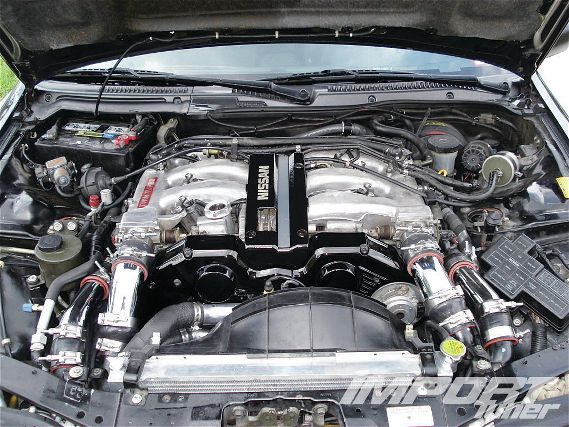 |
B16A1 Honda Engine Swap - Question It
|
B16A1 Honda Engine Swap - Question It
I’m not sure if you were communicating clearly with the shop that built your car, but it sounds to me like you guys were both working toward a different set of goals.
Problem #1: If you told them you wanted 500 rwhp, then the 550cc/min injectors are too small (for pump gas at least). You would need the Nismo 740cc/min injectors and a high-flow fuel pump to match. I’d recommend the Nismo Skyline GT-R pump, but if you’re on a budget, a Walbro 255lph will do.
Problem #2: I believe the JWT Sport 500 turbos are good for 500 brake horsepower. For 500 whp, you would probably need the JWT Sport 600s or 650s, depending on whether or not you have higher lift/duration camshafts or other head work to improve airflow through the engine.
Problem #3: I recommend higher lift/duration camshafts. The VG30’s cylinder heads can use every bit of help they can get since they aren’t the best flowing heads in the world. Not only will the engine flow more air, but you can also make more power with a wider powerband. Both JWT and Tomei have a good selection of VG30DE camshafts.
Problem #4: If you must run catalytic converters, get some 100-cell metal cats and mount them downstream in the exhaust system and not immediately after the turbos. This will vastly improve the performance of any turbo engine. In general, exhaust flow is a huge factor for turbo engine performance. Make sure your exhaust system has large-diameter tubes and straight-through mufflers.
Problem #5: You did not mention what intercoolers you are running. The OEM intercoolers are useless, while aftermarket side-mounted intercoolers are considered slightly better than useless. A large, front-mounted core, such as a Greddy unit, offers significant gains over side-mounted cores in the case of the Z32. The problem with side-mount intercoolers is the lack of space to fit intercoolers with a large enough surface area and the lack of proper ducting, which further reduces their effectiveness. Sure, there are people who make 500+ whp with side-mounted intercoolers on the dyno, but try putting those same cars back on the dyno after three laps on the track and tell me if it’s still making 500+ whp. You can never have too much intercooler for your car.

